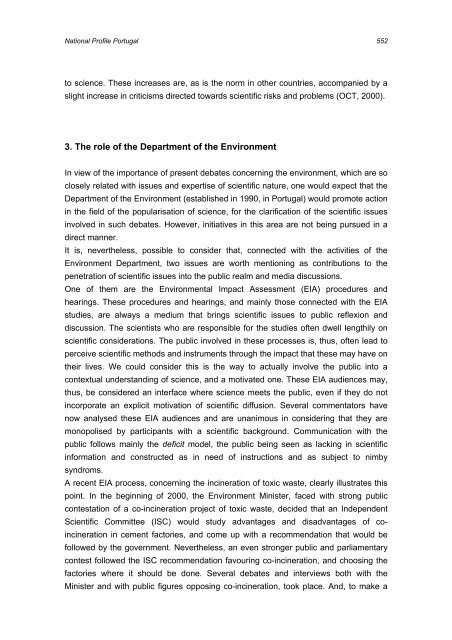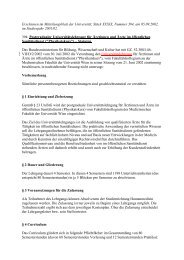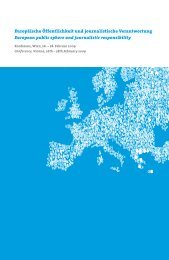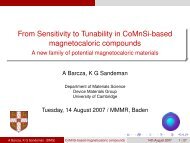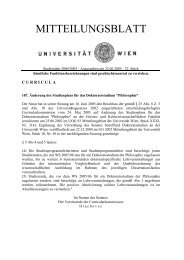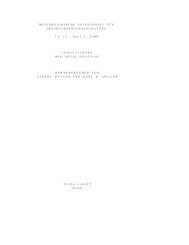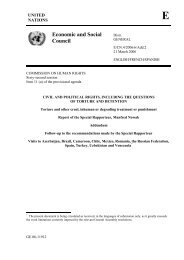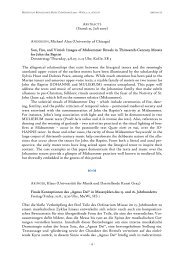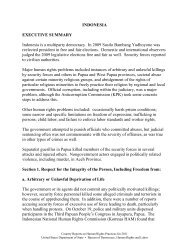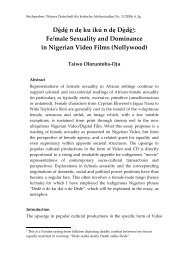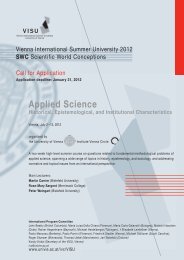- Page 1 and 2:
Final Report Editor Ulrike Felt Jun
- Page 3 and 4:
Members of the Network: Austria: Ul
- Page 5 and 6:
OPUS - Background of the Project 2
- Page 7 and 8:
OPUS - Background of the Project 4
- Page 9 and 10:
OPUS - Background of the Project 6
- Page 11 and 12:
OPUS - Background of the Project 8
- Page 13 and 14:
OPUS - Background of the Project 10
- Page 15 and 16:
OPUS - Background of the Project 12
- Page 17 and 18:
OPUS - Background of the Project 14
- Page 19 and 20:
Conceptualising the relationships b
- Page 21 and 22:
Conceptualising the relationships b
- Page 23 and 24:
Conceptualising the relationships b
- Page 25 and 26:
Conceptualising the relationships b
- Page 27 and 28:
Conceptualising the relationships b
- Page 29 and 30:
Conceptualising the relationships b
- Page 31 and 32:
Conceptualising the relationships b
- Page 33 and 34:
Conceptualising the relationships b
- Page 35 and 36:
Conceptualising the relationships b
- Page 37 and 38:
Conceptualising the relationships b
- Page 39 and 40:
Conceptualising the relationships b
- Page 41 and 42:
Conceptualising the relationships b
- Page 43 and 44:
Conceptualising the relationships b
- Page 45 and 46:
Conceptualising the relationships b
- Page 47 and 48:
Conceptualising the relationships b
- Page 49 and 50:
Conceptualising the relationships b
- Page 51 and 52:
PUS Policies - Introduction 48 EU l
- Page 53 and 54:
PUS Policies - Introduction 50 Howe
- Page 55 and 56:
PUS Policies - Introduction 52 be o
- Page 57 and 58:
PUS Policies - Introduction 54 scie
- Page 59 and 60:
PUS Policies - Introduction 56 meth
- Page 61 and 62:
PUS Policies - Introduction 58 envi
- Page 63 and 64:
Austrian policies on Public Underst
- Page 65 and 66:
Austrian policies on Public Underst
- Page 67 and 68:
Austrian policies on Public Underst
- Page 69 and 70:
Austrian policies on Public Underst
- Page 71 and 72:
Austrian policies on Public Underst
- Page 73 and 74:
The Belgian policy context 70 and t
- Page 75 and 76:
The Belgian policy context 72 Consu
- Page 77 and 78:
The Belgian policy context 74 •
- Page 79 and 80:
The Belgian policy context 76 R&D p
- Page 81 and 82:
Public Understanding of Science in
- Page 83 and 84:
Public Understanding of Science in
- Page 85 and 86:
Public Understanding of Science in
- Page 87 and 88:
Public Understanding of Science in
- Page 89 and 90:
Policy-public interface in Portugal
- Page 91 and 92:
Policy-public interface in Portugal
- Page 93 and 94:
PUS-Policy: The Swedish Context 90
- Page 95 and 96:
PUS-Policy: The Swedish Context 92
- Page 97 and 98:
PUS-Policy: The Swedish Context 94
- Page 99 and 100:
PUS-Policy: The Swedish Context 96
- Page 101 and 102:
PUS-Policy: The Swedish Context 98
- Page 103 and 104:
Public Understanding of Science and
- Page 105 and 106:
Public Understanding of Science and
- Page 107 and 108:
Public Understanding of Science and
- Page 109 and 110:
Public Understanding of Science and
- Page 111 and 112:
Public Understanding of Science and
- Page 113 and 114:
Spaces where publics encounter „t
- Page 115 and 116:
Spaces where publics encounter „t
- Page 117 and 118:
Spaces where publics encounter „t
- Page 119 and 120:
Spaces where publics encounter „t
- Page 121 and 122:
Science, technology and the media i
- Page 123 and 124:
Science, technology and the media i
- Page 125 and 126:
Science, technology and the media i
- Page 127 and 128:
Science, technology and the media i
- Page 129 and 130:
Science, technology and the media i
- Page 131 and 132:
Science, technology and the media i
- Page 133 and 134:
Technoscience in the Austrian media
- Page 135 and 136:
Technoscience in the Austrian media
- Page 137 and 138:
Technoscience in the Austrian media
- Page 139 and 140:
Technoscience in the Austrian media
- Page 141 and 142:
Technoscience in the Austrian media
- Page 143 and 144:
Technoscience in the Austrian media
- Page 145 and 146:
Technoscience in the Austrian media
- Page 147 and 148:
Technoscience in the Austrian media
- Page 149 and 150:
Science and the media in Belgium 14
- Page 151 and 152:
Science and the media in Belgium 14
- Page 153 and 154:
Science and the media in Belgium 15
- Page 155 and 156:
Science and the media in Belgium 15
- Page 157 and 158:
French media 154 A - Introduction F
- Page 159 and 160:
French media 156 known for presenti
- Page 161 and 162:
French media 158 examinations, alte
- Page 163 and 164:
French media 160 Obviously, the con
- Page 165 and 166:
French media 162 Another trend has
- Page 167 and 168:
French media 164 could say that cri
- Page 169 and 170:
French media 166 The use of the Int
- Page 171 and 172:
French media 168 dozen pages to hig
- Page 173 and 174:
French media 170 hybrid creation vi
- Page 175 and 176:
French media 172 attempt to "reconc
- Page 177 and 178:
Media and PUS in Portugal 174 1. Ba
- Page 179 and 180:
Media and PUS in Portugal 176 issue
- Page 181 and 182:
Media and PUS in Portugal 178 2001,
- Page 183 and 184:
Media and internet in the Swedish c
- Page 185 and 186:
Media and internet in the Swedish c
- Page 187 and 188:
Media and internet in the Swedish c
- Page 189 and 190:
Media and internet in the Swedish c
- Page 191 and 192:
Media and internet in the Swedish c
- Page 193 and 194:
Media and New Media in the UK 190 S
- Page 195 and 196:
Media and New Media in the UK 192 O
- Page 197 and 198:
Media and New Media in the UK 194 v
- Page 199 and 200:
Media and New Media in the UK 196 m
- Page 201 and 202:
Media and New Media in the UK 198 d
- Page 203 and 204:
Media and New Media in the UK 200 F
- Page 205 and 206:
Media and New Media in the UK 202 t
- Page 207 and 208:
Museums and Science Centres as Spac
- Page 209 and 210:
Museums and Science Centres as Spac
- Page 211 and 212:
Museums and Science Centres as Spac
- Page 213 and 214:
Museums and Science Centres as Spac
- Page 215 and 216:
Museums and Science Centres as Spac
- Page 217 and 218:
Museums and Science Centres as Spac
- Page 219 and 220:
Museums and Science Centres as Spac
- Page 221 and 222:
Museums and Science Centres as Spac
- Page 223 and 224:
Museums and Science Centres as Spac
- Page 225 and 226:
Austrian museums and exhibitions 22
- Page 227 and 228:
Austrian museums and exhibitions 22
- Page 229 and 230:
Austrian museums and exhibitions 22
- Page 231 and 232:
Austrian museums and exhibitions 22
- Page 233 and 234:
Museums and science centres in Belg
- Page 235 and 236:
Museums and science centres in Belg
- Page 237 and 238:
Museums and science centres in Belg
- Page 239 and 240:
Museums and science centres in Belg
- Page 241 and 242:
Exhibiting science and technology i
- Page 243 and 244:
Exhibiting science and technology i
- Page 245 and 246:
Exhibiting science and technology i
- Page 247 and 248:
Exhibiting science and technology i
- Page 249 and 250:
Exhibiting science and technology i
- Page 251 and 252:
Exhibiting science and technology i
- Page 253 and 254:
Exhibiting science and technology i
- Page 255 and 256:
Science museums in the Portuguese c
- Page 257 and 258:
Science museums in Sweden 254 Scien
- Page 259 and 260:
Science museums in Sweden 256 disse
- Page 261 and 262:
Science museums in Sweden 258 In or
- Page 263 and 264:
Science museums in Sweden 260 New i
- Page 265 and 266:
Museums and science centres in the
- Page 267 and 268:
Museums and science centres in the
- Page 269 and 270:
Museums and science centres in the
- Page 271 and 272:
Museums and science centres in the
- Page 273 and 274:
Museums and science centres in the
- Page 275 and 276:
Science Festivals and Weeks as Spac
- Page 277 and 278:
Science Festivals and Weeks as Spac
- Page 279 and 280:
Science Festivals and Weeks as Spac
- Page 281 and 282:
Science Festivals and Weeks as Spac
- Page 283 and 284:
Science Festivals and Weeks as Spac
- Page 285 and 286:
Science Festivals and Weeks as Spac
- Page 287 and 288:
Science Week and festivals in Austr
- Page 289 and 290:
Science Week and festivals in Austr
- Page 291 and 292:
Science weeks and festivals in Fran
- Page 293 and 294:
Science weeks and festivals in Fran
- Page 295 and 296:
Science weeks and festivals in Fran
- Page 297 and 298:
Science weeks and festivals in Swed
- Page 299 and 300:
Science weeks and festivals in Swed
- Page 301 and 302:
Science weeks and festivals in Swed
- Page 303 and 304:
Celebrating science in the UK 300 T
- Page 305 and 306:
Celebrating science in the UK 302
- Page 307 and 308:
Celebrating science in the UK 304 c
- Page 309 and 310:
Universities as actors at the scien
- Page 311 and 312:
Universities as actors at the scien
- Page 313 and 314:
Universities as actors at the scien
- Page 315 and 316:
Universities and their Publics in t
- Page 317 and 318:
Universities and their Publics in t
- Page 319 and 320:
Universities and their Publics in t
- Page 321 and 322:
Universities and their Publics in t
- Page 323 and 324:
Universities and their Publics in t
- Page 325 and 326:
Universities and their Publics in t
- Page 327 and 328:
The emerging role of Belgium univer
- Page 329 and 330:
The emerging role of Belgium univer
- Page 331 and 332:
The emerging role of Belgium univer
- Page 333 and 334:
The emerging role of Belgium univer
- Page 335 and 336:
French universities and PUS 332 Cul
- Page 337 and 338:
French universities and PUS 334 429
- Page 339 and 340:
French universities and PUS 336 443
- Page 341 and 342:
French universities and PUS 338 Art
- Page 343 and 344:
French universities and PUS 340 how
- Page 345 and 346:
Portuguese universities and PUS 342
- Page 347 and 348:
Portuguese universities and PUS 344
- Page 349 and 350:
Universities and PUS in Sweden 346
- Page 351 and 352:
Universities and PUS in Sweden 348
- Page 353 and 354:
PUS in British academia 350 Introdu
- Page 355 and 356:
PUS in British academia 352 • Pub
- Page 357 and 358:
PUS in British academia 354 Model a
- Page 359 and 360:
Public consultation and foresight e
- Page 361 and 362:
Public consultation and foresight e
- Page 363 and 364:
Public consultation and foresight e
- Page 365 and 366:
Public consultation and foresight i
- Page 367 and 368:
Public consultation and foresight i
- Page 369 and 370:
Public consultation and foresight i
- Page 371 and 372:
Consultation and foresight in the B
- Page 373 and 374:
Consultation and foresight in the B
- Page 375 and 376:
Consultation and foresight in the B
- Page 377 and 378:
Public consultation and foresight e
- Page 379 and 380:
Public consultation and foresight e
- Page 381 and 382:
Public consultation and foresight e
- Page 383 and 384:
Public consultation and foresight e
- Page 385 and 386:
Public consultation and foresight e
- Page 387 and 388:
Public consultation and foresight e
- Page 389 and 390:
Public consultation and foresight e
- Page 391 and 392:
Public consultation and foresight e
- Page 393 and 394:
Public consultation and foresight e
- Page 395 and 396:
Public consultation and foresight e
- Page 397 and 398:
Public Consultation and Technology
- Page 399 and 400:
Public Consultation and Technology
- Page 401 and 402:
Public Consultation and Technology
- Page 403 and 404:
Public Consultation and Technology
- Page 405 and 406:
Public Consultation and Technology
- Page 407 and 408:
Non-governmental initiatives in PUS
- Page 409 and 410:
Non-governmental initiatives in PUS
- Page 411 and 412:
Non-governmental initiatives in PUS
- Page 413 and 414:
Non-governmental initiatives in PUS
- Page 415 and 416:
NGOs and non-governmental initiativ
- Page 417 and 418:
NGOs and non-governmental initiativ
- Page 419 and 420:
NGOs and non-governmental initiativ
- Page 421 and 422:
NGOs and non-governmental initiativ
- Page 423 and 424:
NGOs and non-governmental initiativ
- Page 425 and 426:
NGOs and non-profit associations in
- Page 427 and 428:
NGOs and non-profit associations in
- Page 429 and 430:
NGOs and non-profit associations in
- Page 431 and 432:
Non-governmental PUS initiatives in
- Page 433 and 434:
Non-governmental PUS initiatives in
- Page 435 and 436:
Non-governmental PUS initiatives in
- Page 437 and 438:
Non-governmental PUS initiatives in
- Page 439 and 440:
Non-governmental PUS initiatives in
- Page 441 and 442:
Non-governmental PUS initiatives in
- Page 443 and 444:
Non-governmental PUS initiatives in
- Page 445 and 446:
Non-governmental initiatives in PUS
- Page 447 and 448:
Non-governmental PUS initiatives in
- Page 449 and 450:
Non-governmental PUS initiatives in
- Page 451 and 452:
The "PUS Industry" in the UK 448 In
- Page 453 and 454:
The "PUS Industry" in the UK 450 Th
- Page 455 and 456:
The "PUS Industry" in the UK 452 we
- Page 457 and 458:
The "PUS Industry" in the UK 454 pu
- Page 459 and 460:
The "PUS Industry" in the UK 456 Mo
- Page 461 and 462:
Governmental initiatives in PUS 458
- Page 463 and 464:
Governmental initiatives in PUS Cul
- Page 465 and 466:
Governmental initiatives in PUS in
- Page 467 and 468:
Governmental initiatives in PUS in
- Page 469 and 470:
Governmental initiatives in PUS in
- Page 471 and 472:
Governmental initiatives in PUS in
- Page 473 and 474:
Belgian governmental initiatives Be
- Page 475 and 476:
Belgian governmental initiatives
- Page 477 and 478:
Belgian governmental initiatives Al
- Page 479 and 480:
French governmental actions 476 was
- Page 481 and 482:
French governmental actions 478 5 -
- Page 483 and 484:
French governmental actions 480 2 -
- Page 485 and 486:
Governmental initiatives in Portuga
- Page 487 and 488:
Governmental initiatives in Portuga
- Page 489 and 490:
Governmental initiatives in Sweden
- Page 491 and 492:
Governmental initiatives in Sweden
- Page 493 and 494:
Governmental initiatives in Sweden
- Page 495 and 496:
The role of UK Government in PUS 49
- Page 497 and 498:
The role of UK Government in PUS 49
- Page 499 and 500:
The role of UK Government in PUS 49
- Page 501 and 502:
The role of UK Government in PUS 49
- Page 503 and 504: National Profiles on Public Underst
- Page 505 and 506: National Profile Austria 502 720 Se
- Page 507 and 508: National Profile Austria 504 the wi
- Page 509 and 510: National Profile Austria 506 Post W
- Page 511 and 512: National Profile Austria 508 scienc
- Page 513 and 514: National Profile Austria 510 enligh
- Page 515 and 516: National Profile Belgium 512 Openin
- Page 517 and 518: Belgian overview 514 far behind in
- Page 519 and 520: Belgian overview 516 2.1.1. The Par
- Page 521 and 522: Belgian overview 518 • To impleme
- Page 523 and 524: Belgian overview 520 (the French-sp
- Page 525 and 526: Belgian overview 522 and the intern
- Page 527 and 528: Belgian overview 524 3. Specific PU
- Page 529 and 530: Belgian overview 526 • Focus Rese
- Page 531 and 532: Belgian overview 528 4.2. Involveme
- Page 533 and 534: National Profile France 530 An hist
- Page 535 and 536: National Profile France 532 evoluti
- Page 537 and 538: National Profile France 534 to its
- Page 539 and 540: National Profile France 536 critici
- Page 541 and 542: National Profile France 538 Selecti
- Page 543 and 544: National Profile France 540 FOX R.,
- Page 545 and 546: National Profile France 542 SCHIELE
- Page 547 and 548: National Profile Portugal 544 are m
- Page 549 and 550: National Profile Portugal 546 2000)
- Page 551 and 552: National Profile Portugal 548 The
- Page 553: National Profile Portugal 550 in en
- Page 557 and 558: National Profile Portugal 554 contr
- Page 559 and 560: National Profile Portugal 556 6. No
- Page 561 and 562: National Profile Portugal 558 So, w
- Page 563 and 564: National Profile Portugal 560 4. Wh
- Page 565 and 566: National Profile Sweden 562 Initiat
- Page 567 and 568: National Profile Sweden 564 Three
- Page 569 and 570: National Profile Sweden 566 In the
- Page 571 and 572: National Profile Sweden 568 univers
- Page 573 and 574: National Profile Sweden 570 directi
- Page 575 and 576: National Profile Sweden 572 being a
- Page 577 and 578: National Profile Sweden 574 some of
- Page 579 and 580: National Profile Sweden 576 by deba
- Page 581 and 582: National Profile Sweden 578 Reviews
- Page 583 and 584: National Profile Sweden 580 them es
- Page 585 and 586: National Profile Sweden 582 differ
- Page 587 and 588: National Profile Sweden 584 In 1994
- Page 589 and 590: National Profile Sweden 586 Region
- Page 591 and 592: National Profile Sweden 588 IV. Sum
- Page 593 and 594: National Profile United Kingdom 590
- Page 595 and 596: National Profile United Kingdom 592
- Page 597 and 598: National Profile United Kingdom 594
- Page 599 and 600: National Profile United Kingdom 596
- Page 601 and 602: National Profile United Kingdom 598
- Page 603 and 604: National Profile United Kingdom 600
- Page 605 and 606:
National Profile United Kingdom 602
- Page 607 and 608:
National Profile United Kingdom 604
- Page 609 and 610:
National Profile United Kingdom 606
- Page 611 and 612:
National Profile United Kingdom 608
- Page 613 and 614:
Comparative Perspective 610 CHAPTER
- Page 615 and 616:
Comparative Perspective 612 Belgian
- Page 617 and 618:
Comparative Perspective 614 811 exp
- Page 619 and 620:
Comparative Perspective 616 Funding
- Page 621 and 622:
Comparative Perspective 618 2. Cent
- Page 623 and 624:
Comparative Perspective 620 The res
- Page 625 and 626:
Comparative Perspective 622 and its
- Page 627 and 628:
Comparative Perspective 624 France
- Page 629 and 630:
Comparative Perspective 626 United
- Page 631 and 632:
Comparative Perspective 628 Portuga
- Page 633 and 634:
Comparative Perspective 630 climate
- Page 635 and 636:
Comparative Perspective 632 Austria
- Page 637 and 638:
Comparative Perspective 634 United
- Page 639 and 640:
Comparative Perspective 636 Action
- Page 641 and 642:
Comparative Perspective 638 governm
- Page 643 and 644:
Comparative Perspective 640 between
- Page 645 and 646:
Comparative Perspective 642 challen
- Page 647 and 648:
Comparative Perspective 644 STS and
- Page 649 and 650:
One science - many Europes? 646 exi
- Page 651 and 652:
One science - many Europes? 648 int
- Page 653 and 654:
One science - many Europes? 650 som
- Page 655 and 656:
One science - many Europes? 652 Int
- Page 657 and 658:
One science - many Europes? 654 Whe
- Page 659 and 660:
One science - many Europes? 656 mak
- Page 661 and 662:
One science - many Europes? 658 818
- Page 663 and 664:
One science - many Europes? 660 iss
- Page 665 and 666:
One science - many Europes? 662 pro
- Page 667 and 668:
One science - many Europes? 664 823
- Page 669 and 670:
One science - many Europes? 666 It
- Page 671 and 672:
One science - many Europes? 668 - b
- Page 673 and 674:
Concluding remarks 670 these concep
- Page 675 and 676:
Concluding remarks 672 “scientifi
- Page 677 and 678:
Concluding remarks 674 fields in sc


